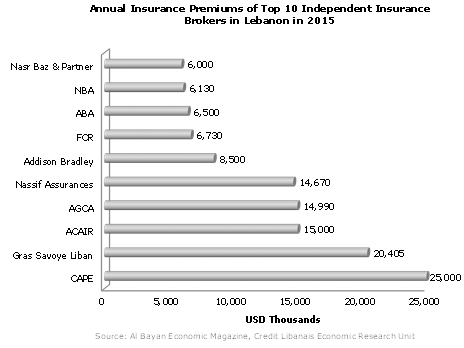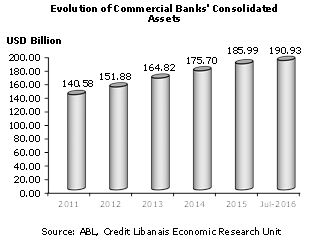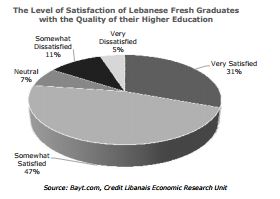Credit Libanais Publishes a Report Titled “Capital Investment Program: A Focus on the Transportation Sector”
During April of the current year, the Lebanese government adopted a “Capital Investment Program” (CIP) that focuses on the development and rehabilitation of major infrastructure projects in Lebanon, with a total estimated cost of around $23 billion, extending over a period of 12 years (2018-2030) divided into three phases of 4 years each, and including a total of over 280 projects. This report, drafted by the Credit Libanais Economic Research Unit, presents a brief overview of the transportation sector projects within the CIP, which detain the lion’s share of allocated funds, amounting to $7.38 billion or the equivalence of 32% of the total CIP envisaged cost. Transportation-related investments will be allocated over 24 separate projects, the potential economic and environmental impact of which are highlighted in this paper.
Lebanon suffers from severe congestion conditions due to years of neglect and lack of urban planning and major investments in basic infrastructure. Furthermore, in the absence of alternatives such as a comprehensive national public transportation system or railway services, the current fleet of transportation means is largely dominated by private vehicles which account for more than 86% of the entire fleet. Daily entrant vehicles to Beirut via the Northern Highway are estimated at 300,000 according to the World Bank, while around 200,000 and 150,000 vehicles arrive via the Southern and Eastern axes respectively per workday. Moreover, the vehicle stock in Lebanon has been significantly growing over the years whereby in 1997, the total number of vehicles circulating across the road network was almost 783,000 at a time when the population was 3.1 million or 0.25 vehicle per capita, reaching an estimated 1.4 million in 2015, according to the Ministry of Environment, against a total population of 5.85 million (including Syrian refugees), the equivalence of 0.24 car per capita (a ratio that would rise to 0.32 were Syrian refugees excluded). To further aggravate the situation, the Syrian refugee crisis has imposed large burdens on the social, political, environmental, and economic levels, most tangible of which can be spotted on the level of the country’s already decaying infrastructure.
Lebanon’s traffic problem imposes heavy burdens and large direct and indirect costs on the country’s economy, setting huge constraints on its growth prospects and hindering it from realizing its potential. Overall, various studies conducted by Lebanese ministries and other international organizations estimate that the economic cost of traffic in Lebanon ranges between 5% and 10% of its Gross Domestic Product (GDP), a ratio that is considered very high, according to the World Bank, when compared to other nations. These costs along with associated opportunity costs display themselves on various levels such as: trade and transport of goods and services, transportation costs (whereby surveys indicate that, generally-speaking, transportation costs constitute an estimated 15% of a regular Lebanese household’s total expenditures, a share that is extensively high when compared to peers in the region), the tragedy of commuting, road safety (whereby the World Health Organization’s (WHO) “Global Status Report on Road Safety 2015” estimated road traffic fatalities at 1,088 in 2015 and GDP loss due to road traffic crashes between 3.2% and 4.8%, higher than most countries around the globe), and investment. Besides the many negative effects traffic conditions and the state of the transportation sector in Lebanon have on its economy, there can be detected additional significant repercussions as well on the country’s environment. According to a study conducted by the Ministry of Environment (MoE) in collaboration with the United Nations Development Programme (UNDP) and the Global Environment Facility (GEF), the transport sector has a very high contribution to air pollution, accounting alone for over 40% of national oil consumption and almost 23.6% of total Greenhouse Gas (GHGs) emissions in Lebanon.
The assessment of the CIP takes into consideration and attempts to depict the extent to which investment in infrastructure influences national performance on the level of both overall productivity in the economy and the geographic distribution and spread of economic activity. Moreover, the approach of the proposed CIP is not limited to generally boosting economic growth and developing local infrastructure, but also accounts for the risks and drawbacks of prevailing regional conflicts on the overall economy and the opportunities that will potentially arise in the aftermath of the termination of said conflicts.
Undoubtedly, the CIP will have a direct and indirect impact on the Lebanese economy through its positive contribution to: employment (expected to generate an estimated 62.65 million labor days of employment according to the Lebanese government, equivalent to a total of 248,611 job opportunities ~ 20,718 job opportunities per year over the entire period of implementation which spans over 12 years), investment, trade and transport of goods and services, and social cohesion and inequality and poverty reduction.
Finally, this research document illustrates the positive repercussions of CIP-related projects on the environment. More specifically, roads rehabilitation and expansion will certainly ease the traffic on major and minor routes outside, at the entrances, and inside the Greater Beirut Area (GBA). As a consequence, less congestion will contribute to decreased GHGs emissions and hence to an improved air quality. Moreover, World Bank estimates reveal that the new public transport scheme proposed under the umbrella of the CIP is projected to decrease congestion by around 16% in the GBA, accounting for a 45,000+ decline in circulating cars per day, equivalent to a reduction in associated negative externalities by 0.5% to 1% of GDP.
Find out more in the attached Credit Libanais “Capital Investment Program: A Focus on the Transportation Sector” research publication. You may also directly access other Credit Libanais’ economic research reports on our website.

بنك الإعتماد اللبناني ينشر تقرير حول برنامج الإنفاق الإستثماري: إضاءة على قطاع النقل
خلال شهر نيسان من العام الحالي، أقرّت الحكومة اللبنانيّة “برنامج الإنفاق الإستثماري” والذي يتضمّن إنشاء وتأهيل أبرز مشاريع البُنى التحتيّة في لبنان، بإجمالي تكلفة تبلغ حوالي 23 مليار د.أ.، على مدى 12 عاماً (2018-2030) مُقَسَّمة على ثلاثة مراحل يمتدّ كلٌّ منها على أربعة سنوات، ويضمّ ما يتخطّى ال280 مشروعاً. يُقدِّم التقرير الذي أنجزته وحدة الأبحاث الإقتصاديّة في بنك الإعتماد اللبناني نظرة عامّة عن مشاريع قطاع النقل ضمن برنامج الإنفاق الإستثماري والتي لها حصّة الأسد من الأموال الملحوظة لتنفيذ البرنامج، بكلفة تبلغ 7.38 مليار د.أ. أو ما يُساوي 32% من الكلفة الإجماليّة للبرنامج، وسوف تتوزًّع الإستثمارات في قطاع النقل على 24 مشروعٍ منفصلٍ، يُلقي هذا التقرير الضوء على أهمّ تَبِعاتها وآثارها الإقتصاديّة والبيئيّة.
يُعاني لبنان من أزمة إزدحام مروري مُستعصية بسبب سنوات مُتتالية من الإستهتار وغياب التخطيط المُدُني ومشاريع الإستثمار في البُنى التحتيّة الأساسيّة في البلاد. بالإضافة، وفي غياب الوسائل البديلة كشبكة شاملة للنقل العام والقطارات، تُشكِّل السيّارات الخاصّة النسبة الأكبر (أكثر من 86%) من أُسطول وسائل النقل في لبنان. ويُقدَّر العدد اليومي للسيّارات التي تدخل إلى بيروت عبر الأوتوستراد الشمالي ب300،000 سيّارة بحسب البنك الدولي، فيما تدخُل حوالي 200،000 و150،000 سيّارة من المدخلين الجنوبي والشرقي بالتتالي خلال كل يوم عمل. كذلك، يشهد عدد السيّارات في لبنان تزايُداً ملحوظاً عبر السنوات حيث بَلَغَ 783،000 في العام 1997 حين كان عدد السّكان حوالي 3.1 مليون ما يُعادل 0.25 سيّارة للفرد الواحد، ليصل إلى 1.4 مليون سيّارة في العام 2015 بحسب إحصاءات وزارة البيئة ل5.85 مليون نسمة (يشمل النازحين السوريّين)، أي ما يُوازي 0.24 سيّارة للفرد الواحد (يرتفع هذا المُعدَّل إلى 0.32 إذا ما إستُثنيَ النزوح السوري). ولِجَعل الأمر أكثر تعقيداً، جاءت أزمة النزوح السوري لتُلقي بثقلها على الأوضاع الإجتماعيّة، السياسيّة، البيئيّة، والإقتصاديّة، وبالتحديد وبشكلٍ ملموس، على البُنى التحتيّة المُهترئة أصلاً.
تُشكِّل أزمة السير والإزدحام المُزمنة حملاً ثقيلاً على الإقتصاد المحلّي بما لها من تأثيرات مُباشرة وغير مُباشرة عليه وبما تفرض من عوائق على النموّ وتحقيق الإمكانيّات والإستفادة منها. بالإجمال، تتراوح الكلفة الإقتصاديّة لزحمة السير في لبنان بحسب دراسات عديدة مُنجَزَة من قِبَل بعض الوزارات اللبنانيّة والمنظّمات الدوليّة ما بين 5% إلى 10% من الناتج المحلّي الإجمالي، وهو مُعدَّل مُرتفع جدّاً نسبيّاً بحسب البنك الدولي. وتبرز هذه التكاليف، المُترافقة مع تكاليف الفرص الضائعة، على عدّة صُعُد مثل: التجارة وحركة النقل، كلفة النقل (بحيث تُشير بعض الإحصاءات إلى أنّه بالإجمال، تُشكِّل تكاليف النقل 15% من مجموع مصاريف الفرد الواحد، وهي نسبة جدّ مُرتفعة مقارنةً بالأرقام المُسَجَّلَة في دول المنطقة)، مأساة التنقُّل، سلامة الطُرُقات (بحيث تُقدِّر منظّمة الصحّة العالميّة في تقرير حالة سلامة الطرقات عالميّاً للعام 2015 عدد الوفيّات نتيجة وضع حركة المرور في لبنان عند 1،088 خلال العام 2015 ونسبة الخسائر الناتجة عن حوادث المرور عند 3.2% إلى 4.8% من الناتج المحلّي الإجمالي، أي أعلى من تلك في مُعظم الدول الأُخرى حول العالم)، والإستثمار. وإلى جانب التأثيرات السلبيّة العديدة على الإقتصاد، يُمكن أيضاً مُلاحظة تداعيات حال الطرقات وقطاع النقل على المُستوى البيئي. فبحسب دراسة عائدة إلى وزارة البيئة، بالتعاوُن مع برنامج الأُمم المتّحدة الإنمائي وصندوق البيئة العالمي، يؤثّر قطاع النقل بشكلٍ كبيرٍ على تلوُّث الهواء، مُشكّلاً ما يزيد عن 40% من الإستهلاك الوطني للنفط وحوالي 23.6% من مجموع إنبعاثات غازات الإحتباس الحراري في لبنان.
ويأخذ تقييم برنامج الإنفاق الإستثماري بعين الإعتبار ويحاول تحديد مدى تأثير الإستثمار على الأداء الوطني على مستويي إجمالي الإنتاجيّة الإقتصاديّة والتوزيع الجغرافي للنشاط الإقتصادي. بالإضافة، إنَّ مقاربة برنامج الإنفاق الإستثماري المُقترح ليست محدودة ضمن نطاق تعزيز النمو الإقتصادي وتنمية البُنية التحتيّة المحلّية، إنّما تلحظ أيضاً المخاطر والإنعكاسات السلبيّة للأزمات الإقليميّة على كامل الإقتصاد كما والفرص التي قد تنشأ بُعَيد إنتهاء هذه الأزمات.
وممّا لا شكّ فيه أنَّه سيكون لبرنامج الإنفاق الإستثماري تأثيرات مباشرة وغير مباشرة على الإقتصاد اللبناني لما له من مساهمة إيجابيّة في كلٍّ من مجالات: التوظيف وخلق فرص العمل (بحيث من المُقَدَّر أن يخلق ما يُقارب ال 62.65 مليون يوم عمل بحسب أرقام الدولة اللبنانيّة، أي ما يُوازي مجموع 248،611 فرصة عمل ~ 20،718 فرصة عمل سنويّاً على مدى إمتداد برنامج الإنفاق الإستثماري والبالغ 12 عاماً)، الإستثمار، التجارة وحركة النقل، والتماسُك الإجتماعي والحدّ من التفاوُت والفقر.
وأخيراً، يفنّد هذا التقرير الآثار الإيجابيّة لمشاريع برنامج الإنفاق الإستثماري المُنتَظَرة على البيئة. فإنَّ عمليّة إعادة تأهيل وتوسيع الطرقات من شأنها أن تُخفّف من الإزدحام على الطرقات الفرعيّة والأساسيّة خارج، على مداخل، وداخل منطقة بيروت الكبرى، ما سيؤدّي إلى تخفيف زحمة السير، ما سيُساهم بدوره في إنخفاض إنبعاثات غازات الإحتباس الحراري وبالتالي في تحسين نوعيّة الهواء. بالإضافة، فقد كَشَفَت تقديرات البنك الدولي أنّه من شأن مُخطّط النقل العام الموضوع ضمن برنامج الإنفاق الإستثماري أن يحدّ من الإزدحام بنسبة 16% في منطقة بيروت الكبرى، أي ما يُساوي تراجُع بأكثر من 45،000 في عدد السيّارات التي تتنقَّل على الطرقات في اليوم الواحد، ما يوازي إنخفاضاً في المُلحقات السلبيّة المُرتبطة به بنسبة 0.5% إلى 1% من الناتج المحلّي الإجمالي
للمزيد من المعلومات، تجدون ربطاً التقرير المفصّل حول برنامج الإنفاق الإستثماري: إضاءة على قطاع النقل والمنظّم من قبل دائرة الأبحاث الإقتصاديّة في بنك الإعتماد اللبناني. كما يمكنكم الإستحصال على التقارير الإقتصاديّة الأخرى المنظّمة من دائرة الأبحاث الإقتصاديّة على موقعنا الالكتروني











